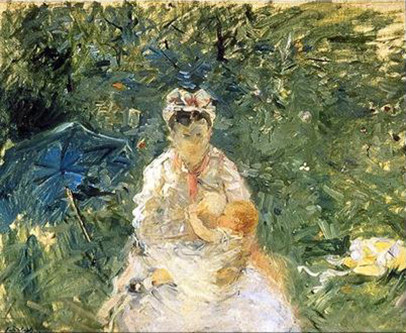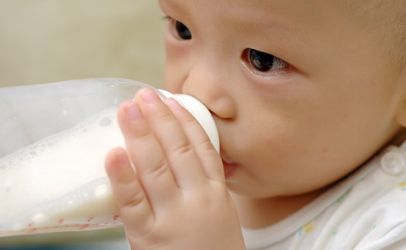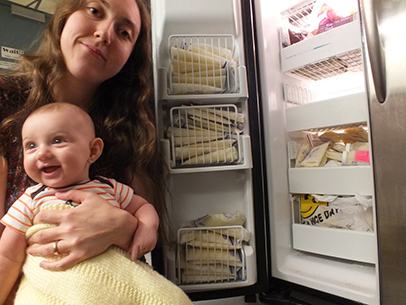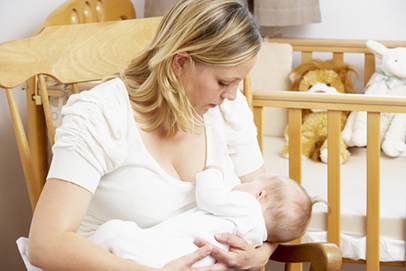There’s nothing new about the sharing of human breast milk. In earlier days, moms in tribal groups nursed babies other than their own when the baby’s mother died or wasn’t close by. Later, wet nurses — mothers who had enough milk to share — came onto the scene. Sometimes they lived with the family; other times, they took the baby home with them. In many cases, they were paid for their services. Some even had licenses to be wet nurses. (Although nowhere as prevalent as in years past, wet nursing still exists as a “job option” today.) Royalty liked wet nursing because it allowed the “royal mother” to have more babies when she was freed from nursing. (In most cases, a woman who exclusively breastfeeds benefits from a natural form of birth control, at least for the first six months.) As a baby, Louis XIV was painted suckling at the breast of a woman who was not his mother. 
 Researchers have also found that breastfed babies have fewer infections and hospitalizations than formula-fed infants. That’s because during breastfeeding, antibodies and other germ-fighting factors pass from a mother to her baby and strengthen the immune system. This, in turn, helps lower a baby’s chances of getting many infections, among them meningitis, pneumonia, diarrhea, and ear and respiratory infections. Cost is another factor. According to “The Simple Dollar,” formula-feeding a baby an average 9,125 ounces for the first year of its life would cost approximately $1,733.75. In developing countries, large companies such as Nestlé promoted formula over breast milk, which caused serious health problems in babies, especially when access to clean water and sanitary conditions weren’t available. The situation because so dire that, in 1981, an international code was adopted to regulate the marketing of breast-milk substitutes. It calls for all formula labels and information to state the benefits of breastfeeding and the health risks of substitutes. It also calls for the end of the promotion of breast milk substitutes, prohibits giving free samples of breast-milk substitutes to pregnant women, mothers or their families, and also prohibits the distribution of free or subsidized substitutes to health workers or facilities. Not all infant nutrition experts are flat-out against formula, with some pointing out that it can sometimes have advantages over nursing. The bottom line, according to an article in “Kids’ Health,” is, “While you’re weighing the pros and cons, talk to your doctor or lactation consultant. These health care providers can give you more information about the options available and help you make the best decision for your family.” The dilemma As more and more doctors, scientists, and moms and dads learned about the benefits of breast milk over formula, many families decided in favor of breastfeeding. But that leaves women who can’t breastfeed for one reason or another in a dilemma. Oftentimes it’s because their bodies can’t make any, or enough, milk for their babies. Sometimes it’s because they’ve gone through medical procedures such as chemotherapy or breast reduction, and other times it’s because they’ve adopted an infant. While milk banks, which follow strict requirements regarding the health of the donor mother and the safety of the donated milk, are excellent sources of donated milk for fragile babies such as preemies, they generally don’t have enough milk for healthy babies. The cost is also prohibitive. In some cases, purchasing milk from a nonprofit milk bank can run as high as $5 an ounce — about $45,625 a year. In the case of premature babies for whom breast milk can be a matter of life and death, insurance often foots the bill, but that’s not the case for healthy babies whose moms can’t nurse. With another option, buying milk online, there are too many chances that the milk may have been diluted with cow’s milk or other ingredients. Then, too, testing hasn’t usually been done for diseases, such as HIV and Hepatitis B, or foodborne pathogens, such as a potentially fatal strain of E. coli, which can be passed on to the baby. And what if the donor is on drugs, or smokes, or drinks too much alcohol? And what about sanitation? How safe will the milk be? And was the donor mother, in pursuit of earning as much money as possible, providing enough of her milk to her own baby?
Researchers have also found that breastfed babies have fewer infections and hospitalizations than formula-fed infants. That’s because during breastfeeding, antibodies and other germ-fighting factors pass from a mother to her baby and strengthen the immune system. This, in turn, helps lower a baby’s chances of getting many infections, among them meningitis, pneumonia, diarrhea, and ear and respiratory infections. Cost is another factor. According to “The Simple Dollar,” formula-feeding a baby an average 9,125 ounces for the first year of its life would cost approximately $1,733.75. In developing countries, large companies such as Nestlé promoted formula over breast milk, which caused serious health problems in babies, especially when access to clean water and sanitary conditions weren’t available. The situation because so dire that, in 1981, an international code was adopted to regulate the marketing of breast-milk substitutes. It calls for all formula labels and information to state the benefits of breastfeeding and the health risks of substitutes. It also calls for the end of the promotion of breast milk substitutes, prohibits giving free samples of breast-milk substitutes to pregnant women, mothers or their families, and also prohibits the distribution of free or subsidized substitutes to health workers or facilities. Not all infant nutrition experts are flat-out against formula, with some pointing out that it can sometimes have advantages over nursing. The bottom line, according to an article in “Kids’ Health,” is, “While you’re weighing the pros and cons, talk to your doctor or lactation consultant. These health care providers can give you more information about the options available and help you make the best decision for your family.” The dilemma As more and more doctors, scientists, and moms and dads learned about the benefits of breast milk over formula, many families decided in favor of breastfeeding. But that leaves women who can’t breastfeed for one reason or another in a dilemma. Oftentimes it’s because their bodies can’t make any, or enough, milk for their babies. Sometimes it’s because they’ve gone through medical procedures such as chemotherapy or breast reduction, and other times it’s because they’ve adopted an infant. While milk banks, which follow strict requirements regarding the health of the donor mother and the safety of the donated milk, are excellent sources of donated milk for fragile babies such as preemies, they generally don’t have enough milk for healthy babies. The cost is also prohibitive. In some cases, purchasing milk from a nonprofit milk bank can run as high as $5 an ounce — about $45,625 a year. In the case of premature babies for whom breast milk can be a matter of life and death, insurance often foots the bill, but that’s not the case for healthy babies whose moms can’t nurse. With another option, buying milk online, there are too many chances that the milk may have been diluted with cow’s milk or other ingredients. Then, too, testing hasn’t usually been done for diseases, such as HIV and Hepatitis B, or foodborne pathogens, such as a potentially fatal strain of E. coli, which can be passed on to the baby. And what if the donor is on drugs, or smokes, or drinks too much alcohol? And what about sanitation? How safe will the milk be? And was the donor mother, in pursuit of earning as much money as possible, providing enough of her milk to her own baby? 
 The fact that the shared milk is offered free to moms who need it is an important part of the equation, said Devenot. Charging money for the milk is strictly prohibited. “Without the profit motive, there’s no reason to lie,” she said. “Without money being part of the arrangement, there’s no need to dilute it with cow’s milk, or for moms to shortchange their own babies. It’s the same milk the donors are feeding their own babies. What mother doesn’t want the best for her baby?” Devenot noted that, a few centuries ago, she would have had to resort to a wet nurse. “Sharing milk is as old as human history,” she said. “Peer-to-peer, grassroots community milk-sharing is replicating a tribal, ‘it-takes-a-village’ approach to child-raising for the Internet age. It’s a modern form of wet nursing.” Too much milk Kristen Ribe’s dilemma was the opposite of Devenot’s: She had an oversupply of milk. She realized that one day when she saw all of the surplus breast milk she had pumped and put into the freezer “just in case” her baby, Benjamin, now 18 months and still nursing, would need it one day. She realized she was never going to be able to use all of it, yet the thought of thawing it out and dumping it down the sink dismayed her. “It’s called ‘liquid gold,’ Ribe told Food Safety News. “That’s how precious it is.” She asked a lactation consultant about what she could do with the milk and was referred to the websites for Human Milk 4 Human Babies and Eats on Feets, both of them global networks. By going to those sites and keying into the state where she lived, she could then find possible recipients who lived close by in northern New Jersey. While both of these organizations provide links to milk donors and those needing milk in every state and many countries around the world, they do not make any of the actual connections between the donors and those needing the milk, nor do they provide any recommendations. Instead, they provide the donors and recipients with information they can follow up on to make their own connections and, from there, their own decisions. “The goal is to put more moms together,” she said. “I know breast milk is good for babies, so why not share it?” Referring to breast milk as “truly a gift,” Ribe said it’s up to the moms to make sure they’re OK with everything. “I wanted to meet them and their babies,” she said. “I wanted to know that my milk was going to a good home.” And because the milk is donated, Ribe said that milk-sharing is on a different level from selling milk. “People who donate milk do it because they want to help babies,” she said. “We know it’s a precious resource.” Over the span of nine months, she donated 1,000 ounces of milk that went to three babies. Ribe said she always followed strict sanitation practices and that cleanliness was paramount. Two of Eats on Feets’ four pillars for sharing of breast milk are “safe handling” and “pasteurization” (the other two are “informed choice” and “donor screening”). Go here for detailed information about all four pillars, including the different ways of pasteurizing donated breast milk.
The fact that the shared milk is offered free to moms who need it is an important part of the equation, said Devenot. Charging money for the milk is strictly prohibited. “Without the profit motive, there’s no reason to lie,” she said. “Without money being part of the arrangement, there’s no need to dilute it with cow’s milk, or for moms to shortchange their own babies. It’s the same milk the donors are feeding their own babies. What mother doesn’t want the best for her baby?” Devenot noted that, a few centuries ago, she would have had to resort to a wet nurse. “Sharing milk is as old as human history,” she said. “Peer-to-peer, grassroots community milk-sharing is replicating a tribal, ‘it-takes-a-village’ approach to child-raising for the Internet age. It’s a modern form of wet nursing.” Too much milk Kristen Ribe’s dilemma was the opposite of Devenot’s: She had an oversupply of milk. She realized that one day when she saw all of the surplus breast milk she had pumped and put into the freezer “just in case” her baby, Benjamin, now 18 months and still nursing, would need it one day. She realized she was never going to be able to use all of it, yet the thought of thawing it out and dumping it down the sink dismayed her. “It’s called ‘liquid gold,’ Ribe told Food Safety News. “That’s how precious it is.” She asked a lactation consultant about what she could do with the milk and was referred to the websites for Human Milk 4 Human Babies and Eats on Feets, both of them global networks. By going to those sites and keying into the state where she lived, she could then find possible recipients who lived close by in northern New Jersey. While both of these organizations provide links to milk donors and those needing milk in every state and many countries around the world, they do not make any of the actual connections between the donors and those needing the milk, nor do they provide any recommendations. Instead, they provide the donors and recipients with information they can follow up on to make their own connections and, from there, their own decisions. “The goal is to put more moms together,” she said. “I know breast milk is good for babies, so why not share it?” Referring to breast milk as “truly a gift,” Ribe said it’s up to the moms to make sure they’re OK with everything. “I wanted to meet them and their babies,” she said. “I wanted to know that my milk was going to a good home.” And because the milk is donated, Ribe said that milk-sharing is on a different level from selling milk. “People who donate milk do it because they want to help babies,” she said. “We know it’s a precious resource.” Over the span of nine months, she donated 1,000 ounces of milk that went to three babies. Ribe said she always followed strict sanitation practices and that cleanliness was paramount. Two of Eats on Feets’ four pillars for sharing of breast milk are “safe handling” and “pasteurization” (the other two are “informed choice” and “donor screening”). Go here for detailed information about all four pillars, including the different ways of pasteurizing donated breast milk.  To get the milk to the donor, Ribe and her husband would put the frozen milk packets into a cooler with ice packs and meet the recipient in a pre-arranged location. From there, the recipient would take it home and put it in her freezer. Almost always, the donors and recipients live fairly close to each other. “It’s local because of the ease of transportation,” Ribe said. As for how many people are involved in this sort of endeavor, she said the informal support group for donor mothers she is part of has 500 members. “And we’re just a small percentage of the total number of donors overall,” Ribe said. When she asked the donors in the group if they would want to share information about how much breast milk they had donated, eight of the mothers who responded had donated a total of 73,000 ounces, which went to 50 babies. And one mother had donated 12,000 ounces. “More moms are choosing to share their milk, and more are wanting it,” Ribe said. “It’s more top-of-the-mind now. When it’s done appropriately and safety, it’s so beneficial.” World Milksharing Day is an annual event that takes place every year the last week of September. Advice to families According to a World Health Organization/UNICEF publication, “Global Strategy for Infant and Young Child Feeding,” for those few health situations in which infants cannot, or should not, be breastfed, these are the best choices in order of health benefits to the baby:
To get the milk to the donor, Ribe and her husband would put the frozen milk packets into a cooler with ice packs and meet the recipient in a pre-arranged location. From there, the recipient would take it home and put it in her freezer. Almost always, the donors and recipients live fairly close to each other. “It’s local because of the ease of transportation,” Ribe said. As for how many people are involved in this sort of endeavor, she said the informal support group for donor mothers she is part of has 500 members. “And we’re just a small percentage of the total number of donors overall,” Ribe said. When she asked the donors in the group if they would want to share information about how much breast milk they had donated, eight of the mothers who responded had donated a total of 73,000 ounces, which went to 50 babies. And one mother had donated 12,000 ounces. “More moms are choosing to share their milk, and more are wanting it,” Ribe said. “It’s more top-of-the-mind now. When it’s done appropriately and safety, it’s so beneficial.” World Milksharing Day is an annual event that takes place every year the last week of September. Advice to families According to a World Health Organization/UNICEF publication, “Global Strategy for Infant and Young Child Feeding,” for those few health situations in which infants cannot, or should not, be breastfed, these are the best choices in order of health benefits to the baby:
- Expressed breast milk from an infant’s own mother;
- Breast milk from a healthy wet nurse or a human-milk bank;
- A breast-milk substitute (formula).
This report also points out the following to anyone who thinks breastfeeding is purely a “woman’s issue”: “Governments will be unsuccessful in their efforts to accelerate economic development in any significant long-term sense until optimal child growth and development, especially through appropriate feeding practices, are ensured. “ The U.S. Food and Drug Administration (FDA) recommends that parents looking for a source of breast milk other than the baby’s mother consult a healthcare provider before making any decisions. The agency also warns that those feeding human milk other than from the baby’s mother to consider the possible safety risks for the baby, which can include exposure to infectious diseases, chemical contaminants and some illegal drugs, as well as to a limited number of prescription drugs that might be in the human milk. Foodborne pathogens such as E. coli can also contaminate the milk. The agency recommends against feeding a baby breast milk acquired directly from individuals or through the Internet because the donor is unlikely to have been screened for infectious disease or contamination risk. In addition, states the agency, it is not likely that the human milk has been collected, processed, tested or stored in a way that reduces possible safety risks to the baby. But, if after consultation with a healthcare provider, a parent or caretaker of a baby decides to feed a baby human milk from a source other than its mother, the agency advises that the person only use milk from a source which has screened its milk donors and taken other precautions to ensure the safety of its milk. The agency also recommends contacting state departments of health to get information on human milk banks in a specific area. FDA also points people to the Human Milk Banking Association of North America, a voluntary professional association for human milk banks. The milk-banking organization issues voluntary safety guidelines for member banks on screening donors and on collecting, processing, handling, testing and storing milk. While a few states have required safety standards for such milk banks, FDA has not been involved in establishing these voluntary guidelines or state standards. Diana West, IBCLC (International Board Certified Lactation Consultant) and director of media relations for La Leche League International, said the League’s original policy was that its volunteer counselors could not recommend informal milk-sharing. But as the practice has grown, the policy was updated to allow counselors to share information about all avenues for obtaining and donating milk, including informal sharing. “It’s always important that mothers have the latest and best information about milk donation and sharing,” she said. On a personal level, West said she was grateful to get some donated milk because her own baby had a severe reaction to formula, which she had to use because a previous surgery had limited the amount of milk she could produce. Even so, she advises women who are having problems nursing to first go to sources such as the eighth edition of “The Womanly Art of Breastfeeding,” which, in 2012, was the Readers’ Choice Award Winner as a favorite baby shower gift, to learn if there’s anything they can do to increase how much milk they are producing. Another resource specifically for low milk production issues is “The Breastfeeding Mother’s Guide to Making More Milk.” West also advises mothers receiving donated milk to pasteurize it. “They should do it,” she said. “It will kill bacteria, fungi and viruses but won’t kill the immune factors, and all the nutrition of the breast milk will be there.”
(To sign up for a free subscription to Food Safety News, click here.)
